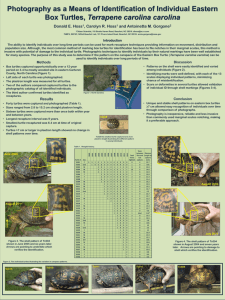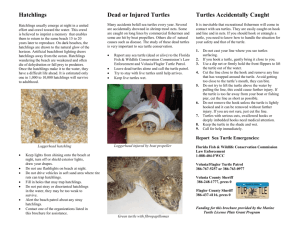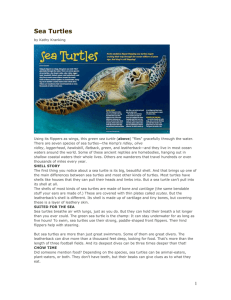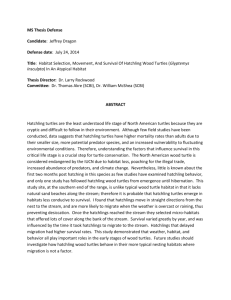In the Wild - The Maryland Zoo in Baltimore
advertisement
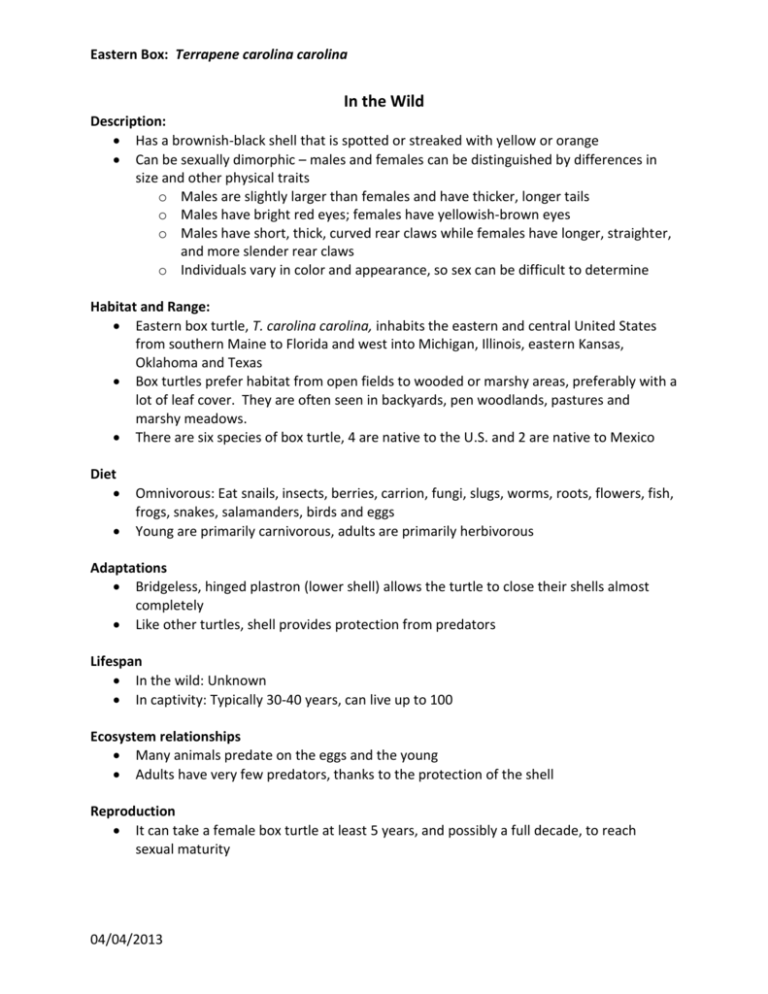
Eastern Box: Terrapene carolina carolina In the Wild Description: Has a brownish-black shell that is spotted or streaked with yellow or orange Can be sexually dimorphic – males and females can be distinguished by differences in size and other physical traits o Males are slightly larger than females and have thicker, longer tails o Males have bright red eyes; females have yellowish-brown eyes o Males have short, thick, curved rear claws while females have longer, straighter, and more slender rear claws o Individuals vary in color and appearance, so sex can be difficult to determine Habitat and Range: Eastern box turtle, T. carolina carolina, inhabits the eastern and central United States from southern Maine to Florida and west into Michigan, Illinois, eastern Kansas, Oklahoma and Texas Box turtles prefer habitat from open fields to wooded or marshy areas, preferably with a lot of leaf cover. They are often seen in backyards, pen woodlands, pastures and marshy meadows. There are six species of box turtle, 4 are native to the U.S. and 2 are native to Mexico Diet Omnivorous: Eat snails, insects, berries, carrion, fungi, slugs, worms, roots, flowers, fish, frogs, snakes, salamanders, birds and eggs Young are primarily carnivorous, adults are primarily herbivorous Adaptations Bridgeless, hinged plastron (lower shell) allows the turtle to close their shells almost completely Like other turtles, shell provides protection from predators Lifespan In the wild: Unknown In captivity: Typically 30-40 years, can live up to 100 Ecosystem relationships Many animals predate on the eggs and the young Adults have very few predators, thanks to the protection of the shell Reproduction It can take a female box turtle at least 5 years, and possibly a full decade, to reach sexual maturity 04/04/2013 Eastern Box: Terrapene carolina carolina Breeding may or may not happen depending on whether a female’s home territory (which she won’t leave) happens to overlap with a male’s home territory (which he won’t leave) Eggs are few in number and may include some infertile ones Hatchlings are extremely vulnerable to predation and few if any will make it to adulthood Box turtle mating season begins in the spring and continues through the summer A male may mate with the same female several years in a row, or with several females, depending on availability Females can lay fertile eggs up to 4 years after a successful mating Females make their nests in the leaf litter and lay 3-8 eggs per clutch Incubation lasts about three months Temperature determines the sex of the young. If eggs are incubated in a temperature range of 72-81 degrees Fahrenheit, the hatchlings will be male. If the incubation temperature is 82 degrees or above, the hatchlings will be female. Activity Diurnal Box turtles are active during the warmer months. They may stay hidden during the hottest part of the day but are still active during daylight hours. Box turtles hibernate through the winter. They take shelter by burrowing up to two feet deep in dirt, mud, stream bottoms, stump holes or mammal burrows. A winter hibernation burrow is called a hibernacula. One or more box turtles may share the same hibernacula. Other “fun facts” Most box turtles spend their entire lives – which can be up to 100 years! – within 250 yards of the nests where they were born o A box turtle makes a mental map of its home territory and knows exactly where to find food throughout the year o If removed from its home territory, it will make every effort to return. It probably will succeed if moved less than a mile or two away, but probably will not if moved further, although it may try for years. Home ranges often overlap and box turtles are not aggressively territorial. They are often found in groups and tolerate others in their territory without displaying aggression. Conservation Status and Threats: Box turtles are not considered threatened or endangered nationally, although some states list them as a species of special concern Eastern box turtles are scarce in parts of their range because of habitat loss, collisions with cars and over-collection for the pet trade In Maryland, it is illegal to take box turtles out of the wild in order to sell them as pets 04/04/2013 Eastern Box: Terrapene carolina carolina Listed as Near Threatened – populations are declining in some areas as a result of habitat loss and fragmentation, collisions with cars and over-collection for the pet trade Given the odds against reproductive success for box turtles, it is important to the longterm viability of any local population to leave it intact and not remove any adults At the Zoo Raphael was confiscated by the Maryland Department of Natural Resources (DNR) and acquired by the Animal Embassy in 1998 from the Reptile House His age and previous history are unknown What We Can Do Never remove a turtle from the wild Never return a pet or rescued turtle to the wild without first contacting the Maryland Department of Natural Resources (DNR) Never relocate a turtle in the wild, unless you see one trying to cross a road – you can help a turtle cross a road only if you can do so safely, and be sure to point it in the same direction that it was headed Educate friends and family about the importance of observing – but not touching, disturbing or collecting – turtles in the wild When visiting wetlands, tread lightly and stay on designated paths Use pesticides and other hazardous materials sparingly and dispose of them properly to ensure that they do not end up in waterways Make environmentally responsible lifestyle decisions to help conserve habitat – conserve energy, reduce litter and pollution Do your research before buying a pet o Make sure you are not purchasing a wild-caught individual. Captive-bred turtle species are often easy to find. o Make sure you know how to properly care for any animal before you decide to buy it as a pet Some things to consider include adequate housing, diet, temperature requirements and lifespan Some pets also require a lot of time and money to be properly cared for References: www.marylandzoo.org www.natureserve.org 04/04/2013


